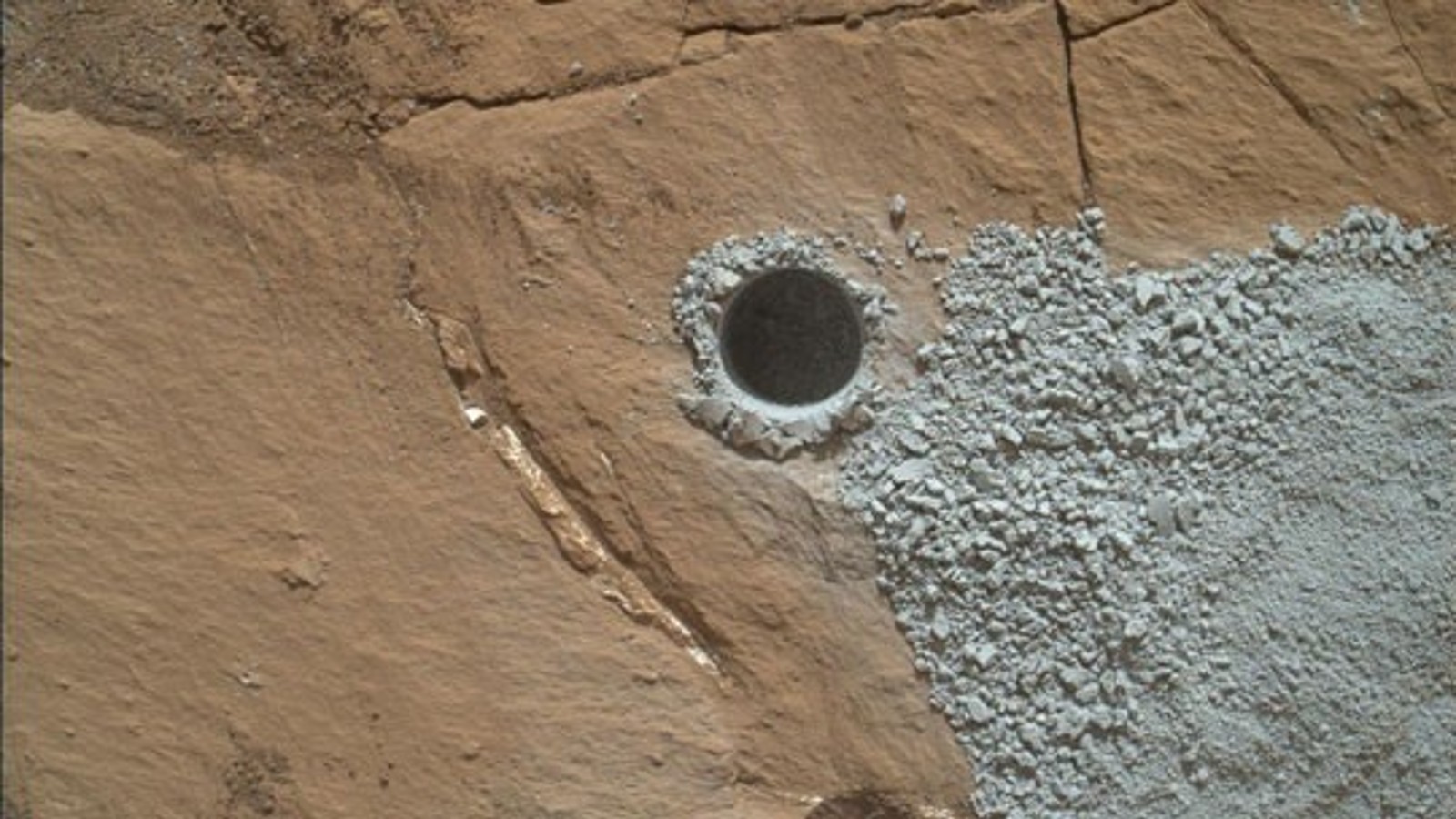Mysterious mineral on Mars was spat out by an explosive eruption 3 billion years ago
NASA's Curiosity rover first uncovered the unusual mineral in 2015.

A mysterious Martian mineral that has perplexed scientists since its discovery seven years ago may have been spat out during an unusual volcanic eruption, researchers have revealed. The mineral, which is normally only found on Earth, was likely formed on the Red Planet more than 3 billion years ago.
NASA's Curiosity rover discovered the mineral inside a rock at the heart of the 96-mile-wide (154 kilometers) Gale crater on July 30, 2015. The rover drilled a small hole into the rock and extracted a silver-colored dust sample. Curiosity's onboard X-ray diffraction laboratory analyzed the dust and detected tridymite — a rare type of quartz made entirely of silicon dioxide, or silica, that is formed by certain types of volcanic activity.
The unusual find was totally unexpected. "The discovery of tridymite in Gale crater is one of the most surprising observations that the Curiosity rover has made in 10 years of exploring Mars," study co-author Kirsten Siebach, a planetary scientist at Rice University in Houston and a mission specialist on NASA's Curiosity team, said in a statement.
The discovery of tridymite stunned researchers for two main reasons, lead study author Valerie Payré, a planetary scientist at Northern Arizona University and Rice University, told Live Science in an email. First, Mars' volcanic activity was previously thought to be unsuitable for producing silica-rich minerals like tridymite. Second, scientists believe Gale crater was once an ancient lake, and it has no visible volcanoes nearby, which left scientists scratching their heads as they tried to figure out how the mineral ended up at the bottom of the lake, Payré said.
Related: Curiosity rover snaps close-up of tiny 'mineral flower' on Mars
In the new study, researchers have come up with an explanation that may finally unravel the mystery. The researchers suspect that the explosive eruption of an unknown volcano launched tridymite-rich ash into the Martian sky, which then fell into the ancient lake at Gale crater.
When the ash fell into the water it would have been broken down into its individual parts by a combination of physical and chemical processes. The researchers think this is why the sample of tridymite is so pure and not contaminated with ash. "If the ashes were directly deposited at the location we found it [without water], we would expect thick layers" of ash, Payré said.
Sign up for the Live Science daily newsletter now
Get the world’s most fascinating discoveries delivered straight to your inbox.
A similar scenario has been observed on Earth at just one location —at Lake Tecocomulco in Mexico, where tridymite was found within volcanic rocks brought up from the bottom of the lake.
If tridymite-rich ash did fall into Gale crater when it was still a lake, then the eruption likely happened between 3 billion and 3.5 billion years ago, which is when researchers suspect the crater was full of water. "The explosive eruption must have happened in that time frame," Payré said. However, recent studies have shown it is possible that Gale crater was still a lake as recently as 1 billion years ago, according to the researchers' statement.

The researchers remain unsure about where the volcano that birthed the tridymite sample is located on the Red Planet. It could have been from a small eruption nearby, or from a massive explosion much further afield, Payré said. It is hard to locate past volcanoes on Mars because it is challenging to distinguish between impact craters and volcanic calderas that have been eroded over billions of years, she added.
The researchers also had to explain how tridymite formed on Mars, where conditions are thought to be very different from Earth.
Normally, tridymite forms in extremely high-temperature and silica-rich volcanic environments, which are common on Earth, Payré said. However, previous evidence from Mars suggests that volcanic eruptions on the Red Planet were basaltic, meaning that they had a much-reduced silica content. This is because Mars doesn't have tectonic plates, which are the main source of Earth's silica-rich eruptions, Payré added.
Further analysis of the tridymite found on Mars revealed that it was slightly different to the tridymite that forms in volcanoes on Earth. This suggests that the Martian version was formed under slightly different conditions, Payré said.
Related: Martian crater looks just like a human fingerprint in this incredible new image
The researchers propose that the tridymite found in Gale crater was formed over a prolonged period within a magma chamber underneath the unknown volcano. The temperature within the chamber would likely have been slightly lower than the conditions in tridymite-forming volcanoes on Earth, but the team believes this might have enabled the mineral to slowly form as additional silica became available, according to the study.
Similar mineral formation pathways have been observed on Earth, and the scenario represents the "straightforward evolution of other volcanic rocks we found in the crater," Siebach said.
Although the proposed formation of tridymite on Mars requires less silica than on Earth, the researchers point out that the volcano that birthed the sample found in Gale crater likely had a higher silica content than past evidence suggested.
"This work suggests that Mars may have a more complex and intriguing volcanic history than we would have imagined before Curiosity," Siebach said.
Future discoveries from Curiosity and its successor, the Perseverance rover, as well as Martian rocks brought back to Earth by NASA's proposed Mars Sample Return mission, could help shed more light on Mars' ancient volcanic past, Payré said.
The study will be published in the Sept. 15 issue of the journal Earth and Planetary Science Letters.
Originally published on Live Science.

Harry is a U.K.-based senior staff writer at Live Science. He studied marine biology at the University of Exeter before training to become a journalist. He covers a wide range of topics including space exploration, planetary science, space weather, climate change, animal behavior and paleontology. His recent work on the solar maximum won "best space submission" at the 2024 Aerospace Media Awards and was shortlisted in the "top scoop" category at the NCTJ Awards for Excellence in 2023. He also writes Live Science's weekly Earth from space series.









